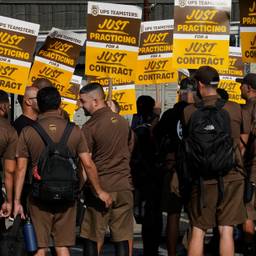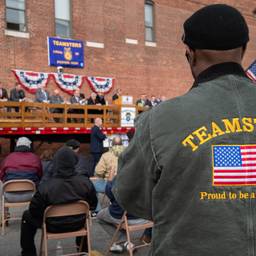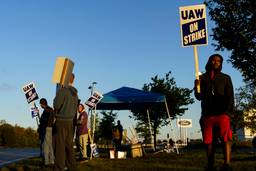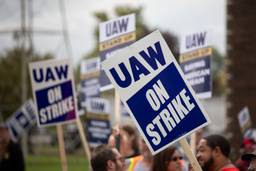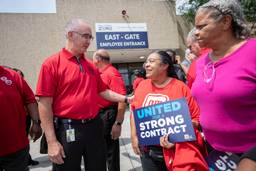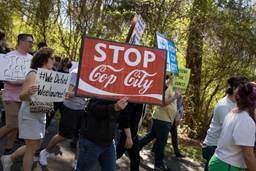The Clock is Ticking for UPS
Bargaining between the Teamsters and UPS has broken down. Can they still reach a deal?
Teddy Ostrow and Ruby Walsh
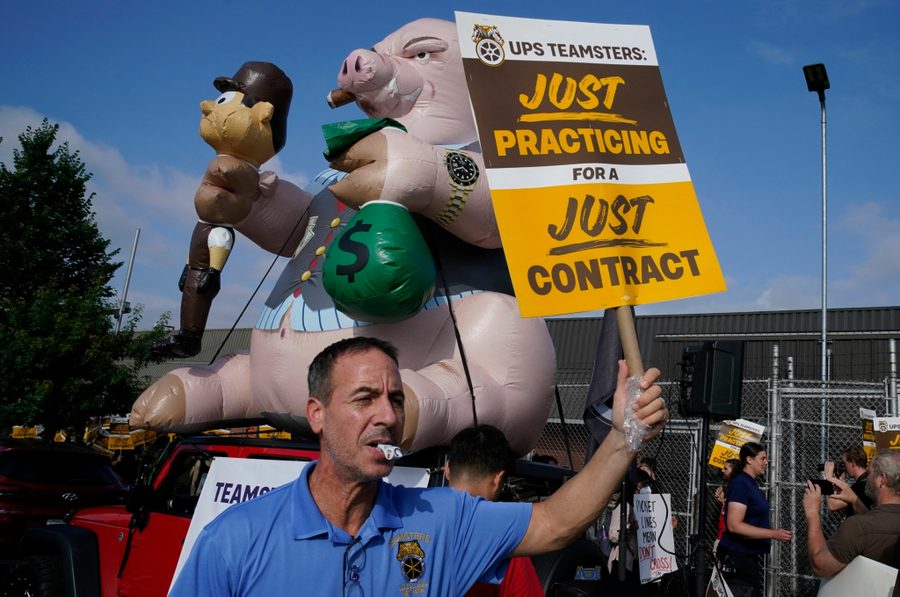
Read the full transcript below.
Negotiations between UPS and the Teamsters have collapsed after disagreement over part-timer wages. With less than a month from contract expiration, the largest single-employer strike in US history is looking more and more likely.
We have another two-part episode this week. First, an update on the contract campaign. The Teamsters gave UPS two deadlines for their last, best, and final offer on proposals. UPS hasn’t met either of them. So the union is upping the ante with practice pickets around the country.
Could a deal materialize or is a strike imminent? We asked Stephen Franklin, a veteran journalist who is the former labor writer for the Chicago Tribune, and an adjunct professor at the University of Illinois Urbana-Champaign School of Labor and Employment Relations.
Next, a deep dive into gig work at UPS and subcontracting more broadly. The Teamsters want to rid their workforce of so-called personal vehicle drivers (PVDs), workers who deliver packages out of their private vehicles and work off a smartphone app, much like other gig workers. We spoke with UPS workers from Georgia, Utah, and California, and a former gig worker from Indiana, about why gig work and other subcontracting is an existential threat to the union.
Gig work is often pitched as flexible for the worker. But in reality, it’s a breakdown of standards that many Teamsters want to uphold at all costs. Even if that means going out on strike.
This transcript has been edited for length and clarity.
Emil Macdonald: I know that last year, a [personal vehicle driver] had their car just stolen. While they were making a delivery, they left the keys in the ignition and they got back in the car and all the packages were gone.
Teddy Ostrow: What if I told you that not all UPS delivery people wore the brown uniform, nor do they all drive the iconic brown truck? That some are gig workers that drive their own cars and work off a smartphone app?
Emil Macdonald: These are the kind of risks that are typical to gig workers. It’s not uncommon for people to get robbed, when they’re out there. It’s a risky situation and you don’t have the kind of protections that I do as a driver.
Teddy Ostrow: Gig work is often pitched as flexible for the worker. But in reality, it’s a breakdown of standards that many Teamsters want to uphold at all costs. Even if that means going out on strike.
Hello, my name is Teddy Ostrow. Welcome to The Upsurge, a podcast about UPS, the Teamsters, and the future of the American labor movement.
This podcast unpacks the unprecedented labor fight this year at UPS. In July, the contract of over 340,000 UPS workers will expire and if those workers strike, which is a real possibility, it will be the largest strike against a single company in US history.
The Upsurge is produced in partnership with In These Times and The Real News Network. Both are nonprofit media organizations that cover the labor movement closely. Check them out at inthesetimes.com and therealnews.com where you can also find an archive of all our past episodes.
And now our short episodic plea: We are a listener-funded podcast. We cannot do this work without you. And it is a lot of work. So please, if you like the show, you have a few bucks to spare every month, head over to patreon.com/upsurgepod and become a supporter today. You can find the link in the description.
Also, we have one more free one-year subscription to In These Times for the next person to sign up to our Patreon. Snag it today.
Alright, onto the show.
Again, we’re coming to you with a two-part episode. First, an update on what’s been going on in the contract campaign, which has been a lot. The Teamsters gave UPS two deadlines for their last, best, and final offer on their economic proposals. And UPS hasn’t met either of them. Could a deal materialize or is a strike imminent? We asked veteran labor journalist Stephen Franklin.
In the second part, we covered a major issue UPSers have been organizing around. That is of course UPS’s use of gig workers to deliver packages, and subcontracting more broadly. The short of it is: the corporation wants to take solid, union jobs, and make them precarious, non-union ones. Stick around to hear what Teamsters and the gig workers themselves think.
Emil Macdonald: I view gig work as a scam.
You’re just a tool for the company to shift liability and maintenance and all these other costs off themselves and onto you.
Teddy Ostrow: But the update first. A lot has happened in negotiations since our last episode. The most recent news is that bargaining between the Teamsters and UPS has broken down. It appears that a strike may be imminent.
We’ll get more into the details. But first, we want to bring you to what’s happening on the ground. We noted it last episode: practice pickets are sprouting up across the country. That’s right, basically pretend picket lines. And since negotiations have broken down, the union has vowed to up the ante.
Chris Wallace, the package car driver from Local 89 we spoke to in Episode 4, was nice enough to bring us to his local’s practice picket at the enormous Worldport Airhub in Louisville.
Workers: Who are we? Teamsters. Who are we? Teamsters.
Joe Sexton: My name’s Joe Sexton. I’m a steward at UPS Worldport, and I’m a 23 year Teamster, with Teamsters Local 89. What we’re doing out here is basically a practice strike to get our members energized for the possibility of us striking the company, to spread information and knowledge, to educate their members on what a strike is, what’s going on with the strike, how we will conduct it— that’s basically what we’re doing out here today.
Teddy Ostrow: For those of you who haven’t gone on strike before, it may seem pretty simple. You just stop working, stand outside your workplace, hold a picket sign, and walk around in circles, maybe do some chants. It’s more complicated than that, but that is kind of what you do on strike. But even that for an inexperienced workforce, can take some practice. I saw it firsthand at Local 804’s practice picket in Brooklyn.
Tony Rosario: We’re gonna walk past, all the way to this area here. We’re walking side by side, and we’re gonna go this way. It’s gonna be tight, but that’s the point. Because when we’re picketing for real, we’re on that one little street, so it’s gotta feel real. There’s not gonna be room to go around trees.
Teddy Ostrow: There are some tried and trusted methods to bolster the impact of a strike. First and foremost is to keep people from crossing the picket line. If UPS can keep its packages flowing, the workers pretty much have no leverage. But there are some legal liabilities, and strikers have to make sure they keep out of trouble. Back to Louisville.
Cody Hibbard: Alright. Can you hear me now? Yeah. Okay, here we go. All right. So my name’s Cody. I’m the attorney for the local. I just wanted to talk a little bit about, how to keep the picket line.
If you all do go on strike, if we do go on strike, the company is gonna allege, in some form or another that our, picket would be unlawful. Local 89 engages in lawful pickets, right? Right. So in order to do that, there’s certain things that you all have to do.
Number one is you have to stick together. That’s the biggest thing. Everyone has to stick together.
Teddy Ostrow: All you have to do is look on social media and you’ll see that every day, the Teamsters strike threat becomes more and more credible.
Now, to discuss negotiations, I spoke with Stephen Franklin, a veteran labor journalist who is the former labor writer for the Chicago Tribune. He’s a Pulitzer Prize finalist and an adjunct professor at the University of Illinois Urbana-Champaign School of Labor and Employment Relations.
I invited him on the show because he just wrote a piece for In These Times magazine titled “Can the Teamsters and UPS reach a deal?” It’s a really good question, so I gave him a call.
Stephen Franklin, welcome to The Upsurge.
Stephen Franklin: Thank you for inviting me.
Teddy Ostrow: So let’s start with a recap of what’s been happening. When we posted our last episode, the Teamsters in UPS just came to dozens of TAs on non-economic issues. They made some progress there, it seems, you know, most, most notably on air conditioning, which was certainly a major demand.
They moved on to economic issues, which of course, are some of the big ticket items. That’s wages, health and welfare benefits, pensions, paid holidays, but also, you know, what will be done on forced overtime and gig workers. So, now, what’s happened since they began discussing the economics?
Stephen Franklin: Well, they’ve collapsed, and essentially, what’s so unusual about this negotiation — in union negotiations, the union typically never says, “We got this. We got that. We got this.” This is very different. This is what Sean O’Brien has been doing, and that’s changed and they have had a number of, of victories.
It appears to be that they’ll be wiping away the second tier wages. They’ll be wiping away the mandatory sixth day. The union has said that the company’s been very tight mouthed on all of this except saying that they want a contract that lets them stay flexible.
So that’s where we’re at and all of a sudden they hit a bump. The company says the union walked away from negotiations and the union says they didn’t, that it was a mutual departure. So we’re at a point of interesting change. I expect that they’re not gonna get back to talks in the next few days or maybe a week or so, and that the union’s going to step up its activities, step up its picketing practices, and make its efforts more known. I’m also going to predict that the bottom line issues are going to be increasing the wages for part-time workers who start today at $15.50 an hour, and dealing with the small, but increasingly large number of people who, like gig workers, drive their own vehicles and make deliveries.
These are called private vehicle drivers.
Teddy Ostrow: That’s a lot of great context. I want to just say, at the beginning of this discussion, we mentioned the bump that is negotiations breaking down. But before that, there have been a couple bumps and then the union said, “We have a deadline for a last best and final offer from you, UPS.”
June 30th, that date came and went. They said, then July 5th, that date came and went. You know, it seems like this is a bargaining strategy of some sorts, as you said. Maybe a deal could be reached, but yeah, let me just bring it back to that — you started to unpack that a bit, but given all that’s occurred, the back and forth, the leaking of UPS’s counter proposal, which really, really angered a number of UPSers, can the Teamsters and UPS still reach a deal?
Stephen Franklin: Yeah, I think that there’s no question that they can reach a deal. Typically unions don’t announce every single victory. Typically, they don’t warn the company a month in advance they’re walking out. So Sean has brought a whole new strategy to what the union is doing. My gut feeling is that it all depends upon the last few days and if he can walk away with a deal that looks like a victory for him, because he’s blown up the expectations so dramatically.
I’ve been talking to Teamsters around the country and as you know, this is an empire of many different parts. The folks at the very top are eager to get a contract, but not as eager as the part-timers and, and so there’s divisions there. Again, I think that the situation will come down to the end.
The danger for the Teamsters is that a strike means less volume, less work — less work means layoffs. The company has been laying off workers. The explanation the workers hear is that the strike is coming, but volume is down. The danger for the company is that if it does go into a strike, its competitors who are all non-union will quickly seize that work.
So I think both of them are going to tip up to the edge. The company must show it’s flexible, it can make money, and there are several reasons why it needs to make money in a declining market, and that’s very important. The union, Sean may have made a mistake in setting such high goals. But if he emphasizes again, as he repeatedly has, great victories on economic issues, it’s been a success, the union has won a lot. They scared the company into that. He can walk away. It all depends on how he promotes it, then ultimately how it goes back to the membership. Remember, the last time the membership voted in 2018, they thought it was a stinky deal and they voted it down and then the union said, “I’m sorry, we don’t listen to workers.”
Teddy Ostrow: Talk about the importance of this for the Teamster membership, getting a good deal, and beyond that, whether it’s a good deal, with no strike or with a strike. What does this mean for the labor movement?
Stephen Franklin: Well, remember, it was only in about the 1970s we saw the introduction of two-tier wages and the UAW collapsed on that issue, so did many other companies. Also the collapse of pensions, that has not happened with the Teamsters, they still have their pensions, but it’s the two-tier wages. So the union needs to push back against the two-tier wage system. That is a critical thing.
I was talking to a Teamster yesterday and she’s been on the job for 11 years as a part-timer, and she makes $20 an hour. It’s not a lot of money and she says she can’t live on it. Most part-timers work two or three jobs if possible, just to get by.
Why they work as part-timers, for many, is that they get this great insurance policy. So it’s a golden handcuff. So for labor, what the Teamsters are doing is what the UAW may do, that take on an aggressive populist approach. If they can win, it’ll set a message back to unions that have been slipping backwards on their heels, trying to survive, making small gains so that you can stand up and do these things.
The problem though is that the dialogue for the last 20 years has really been dominated by what companies have to say. “We’re competing globally,” which in many cases is bullshit. When American companies dominate the world as Caterpillar did for many years, it wiped away the victories the UAW had had.
So two tier wages, loss of pensions, the inability to set a broad scale for other companies, all of this is at stake. If the Teamsters can win, then maybe the UAW can, although they’re gonna have far more difficult problems, because their auto companies are not as stable as UPS. Despite the great publicity about the fights for organizing baristas and folks at smaller companies, blue collar, large unions have not won major victories in the United States.
And that’s where this can be very important. There’s a long trail of who will benefit from this. If the Teamsters win, it’ll benefit unions. If unions win, it’ll benefit the Democrats, it may show unions may have a point, and the failure of blue collar workers to show allegiance or support as they once did for Democrat votes will be returned in some way.
So I think there’s a whole string of potential impacts here. At the same time, there’s a string of potential losses. So it’s a risky situation.
Teddy Ostrow: Steven Franklin, thanks for joining me on The Upsurge.
Stephen Franklin: Thank you for inviting me. Bye.
Teddy Ostrow: That was Stephen Franklin and you can find his piece in In These Times. You should expect more of his coverage of the UPS negotiations coming soon.
Teddy Ostrow: And now for the second part of the show.
Picture this. You ordered something online, you see that UPS is shipping it. It’ll come in a few days. You’re waiting anxiously at home, and suddenly someone pulls up in front of your home in a… Toyota. They get out of the car, package in hand, and begin walking down your driveway to your front door. There’s no brown truck, no brown uniform. Maybe an orange construction vest, and, well, a Toyota, packed to the brim with cardboard boxes. How the heck can they see out their back window, you wonder?
That person that you saw isn’t a typical UPS worker. They’re called a PVD, or personal vehicle driver. They’re called that for obvious reasons. They deliver UPS packages out of their personal vehicles, and they work through a smart phone app, kinda like other gig workers, like Uber and Lyft drivers, or Doordash delivery people.
In this episode, we’re gonna dig into these mysterious PVDs. You’ll hear from some UPS package car drivers.
Demetria Shaw: Now, the first thing I thought was, I wouldn’t be tearing up my car like that.
Teddy Ostrow: And you’ll hear from a PVD themself on what it’s like to do gig work at Big Brown.
PVD: Yeah, it was kind of, kind of crazy how they just kind of threw me to the wolves there and just, you know, never meeting me, seeing me, just here’s 300 packages, let’s put ‘em in your garage and you go deliver ‘em.
Teddy Ostrow: Now, we haven’t touched on PVDs much in The Upsurge. But their existence are among the central issues of this year’s contract campaign. The Teamsters want to get rid of them, because they represent a threat to UPSers’ coveted, union jobs.
Emil Macdonald: UPS would like nothing more than to replace a large part of the package car driver’s job, with employees that they can hire and fire at will as they need them.
Teddy Ostrow: But the problem isn’t just PVDs. The problem is also subcontracting in general, or hiring non-union workers to do union work. Teamsters see this as an existential threat.
Tony Winters: The loss of jobs, has been extremely hazardous and it’s causing turmoil, anxiety, it’s causing desperation, it’s causing heartache.
Teddy Ostrow: There’s not that much information out there about PVDs. I struggled to find even a figure on how many there are, but they certainly reach in the thousands. So, this wasn’t the simplest of episodes to make. My intuition was first to go talk to some package car drivers. After all, they are the ones who interact with the PVDs the most, and it’s their work that’s being taken by people in their personal vehicles. So I called one.
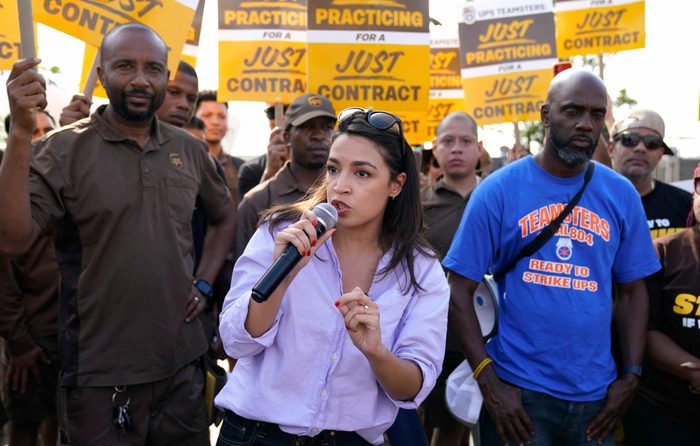
Demetria Shaw: Demetria Shaw, everybody at work calls me D Shaw.
Teddy Ostrow: Demetria has been a package car driver for 15 years in Atlanta, Georgia, out of Teamsters Local 728. We spoke as she sat in her car between errands, with her young son in the backseat. I asked her to tell me about when she first became aware of these gig-like workers. She said it was roughly five years ago.
Demetria Shaw: I would see them at the gate, waiting to come in or pulling in, waiting to fill up their cars. Now, the first thing I thought was, I mean, hey, I wouldn’t be tearing up my car like that, but, but technically in the beginning, I really didn’t think anything of it.
Teddy Ostrow: Demetria wasn’t alone. PVDs started to appear around the country during peak season, that’s around the holidays when delivery work gets really busy. They’ve been around as early as 2017 in some areas. And as the years went on, drivers started to see more and more of them at every peak. The problems started to become evident.
Demetria Shaw: So my idea changed once the less senior drivers were getting off early. And I kept asking, why are these people getting off so early?
Teddy Ostrow: Normally during peak season, workers would expect a decent amount of overtime. But PVDs started eating into that, which was frustrating for some workers. Especially because some of these PVDs were being paid a few bucks more per hour than less senior drivers. Meanwhile, regular package car drivers were being told to go meet up with gig workers at their houses, at random meet up spots, specifically to take work off their brown truck and give it to the PVDs.
Demetria Shaw: You know, so it started to be an issue. You’re taking thousands of packages to these pods for these people to pull up and load their cars and trucks up. It was crazy
Teddy Ostrow: Within a few years UPS’s use of these PVDs became systematic. Gig workers in their personal cars were working 9-5 jobs at UPS during peak season. Some even got overtime bonuses.
Emil Macdonald: That was sort of the way that UPS handled all the excess residential volume during peak season, was to use seasonal drivers.
Teddy Ostrow: That’s Emil Macdonald from Local 315 in Martinez, California, another package car driver. He’s been at UPS for less time than Demetria, but he too saw the rise of PVDs. He entered the package car right before the covid pandemic started, shortly before the ecommerce boom had drivers working six days a week, up to 14 hours a day..
Emil Macdonald: We basically had to deal with this huge, huge increase in demand, people ordering toilet paper. whatever they needed through the mail, because a lot of stuff was shut down.
We got really backed up. There were just piles and piles of packages stacked up in the hubs and in trailers out in the yard, and stuff was arriving like a week late. You’d go out there and you’d hit your maximum hours and you’d still have, you know, 40, 50 packages left on your truck when you got back to the building.
Teddy Ostrow: The explosion of volume was untenable. Something had to give.
Emil Macdonald: After a while, my understanding is that in many places, including mine, the union was able to come to an agreement with the company to use PVDs to help get through some of this excess volume.
Peak season is when UPS is contractually allowed to use seasonal drivers. You used to have a certain number of seasonal drivers delivering at U-Haul, now you have, I’m guessing probably depending on the time, you know, 30, 40, 50 drivers delivering outta their cars.
Teddy Ostrow: The rise of PVDs caught many locals off guard. But Emil explained that a lot of drivers actually appreciated the help. During peak season they no longer were working 12 to 14 hour days, struggling to finish their delivery routes to get home at 11pm at night.
During the height of COVID, there was so much work that some Teamster locals agreed to let UPS use PVDs year round. And the practice still stands. But for many drivers, it started to get excessive. According to Emil, some UPS package car drivers, their entire route was simply dropping off packages to different PVDs, instead of just delivering those packages to homes and businesses themselves.
Emil and other Teamsters activists started to see this gig work for what it was.
Emil Macdonald: I’ll tell you with PVDs, a lot of drivers understand the threat that this poses to our work over the long term. UPS would like nothing more than to replace a large part of the package car driver’s job, specifically residential deliveries, with employees that they can hire and fire at will as they need them. It could save them a lot in terms of how many package cars they send out.
Teddy Ostrow: In other words, PVDs are more disposable than protected, union package car drivers. That’s pretty cost effective for the company. Other gig workers like Uber and Lyft drivers are often misclassified as independent contractors. Meaning they’re not employees and they don’t get all the protections that come with that status.
PVDs actually are employees. They’re seasonal employees that are technically covered in the union contract, and some even pay union fees to be able to work. But the problem is there’s rarely enough time for the union to reach out to them. The casual and transient nature of the work means these workers can’t really exercise the rights and protections they’re supposed to have on the job.
Teamsters fear that their proliferation could create a wedge for UPS’s further deterioration of their union jobs.
Emil Macdonald: The key with this contract is that when we talk about this issue, it’s a threat to what we bring to the table as UPS drivers, just kind of a deskilling of the expertise that we bring to the job. So if UPS can make this package car driver role easier to replace, they would love to do that.
Teddy Ostrow: Some locals in the union have been fighting back through arbitration, or the procedure unions have to address any company violations of the contract. Indeed, in the 2018 national master agreement, there’s actually some language that was intended to prohibit PVDs altogether. Article 26. Section 1:
“No package car driver shall be forced to use his or her personal vehicle to deliver packages.”
Clear as day, right? And that was reflected in some arbitration wins by the union, at Local 804 in New York and 710 in Chicago. But nonetheless, the practice has continued, and many UPSers want stronger language in the next contract to put an end to PVDs once and for all.
Now, we’ve been talking a lot about PVDs, but I also wanted to talk to a PVD. After all it’s these drivers that are working the apparently deteriorated version of the delivery position.
Chris Weathers: I started as a PVD, I think it was winter, October-ish, November of ‘21.
Teddy Ostrow: That’s Chris Weathers out of Lafayette, Indiana. He was a PVD in the peak of 2021. He first heard about the gig when his friend posted about it on social media.
Chris Weathers: He put something on Facebook, that UPS was offering a bonus. I was like, yeah, I could use the money. So, I did that and I put my application in literally like two days later. I was delivering, the whole thing was pretty informal.
Teddy Ostrow: Chris wasn’t even interviewed. He applied and…
Chris Weathers: Then the next day Todd had called me, my center manager, and he’s like, “Hey, can you start work?” And then I was like, do I come in, what do I do? And he is like, “No, we’ll just drop your packages off at your house tomorrow.” And then they’ll come with a phone. There really wasn’t much guidance.
Teddy Ostrow: UPS’s system for dealing with PVDs is different around the country. Some get more guidance than others. But for Chris, there was barely any training, no orientation, nothing. Which was strange to him because it’s a pretty physical job, and it’s easy to hurt yourself carrying heavy packages.
Chris Weathers: I didn’t go to the center or nothing. I was blind, you know, they showed up and the guy that was dropping the stuff off to me, he’s like, “I don’t have a phone for you or anything.”
And I’m like, well, how do I know what to do? And he’s like, “Maybe they’re coming, maybe they’re not.” So yeah, it was kind of, kind of crazy how they just kind of threw me to the wolves there and just, never meeting me, never seeing me, just here’s 300 packages, let’s put ‘em in your garage and you go deliver ‘em.
Teddy Ostrow: Chris learned the ropes pretty fast. He eventually was given a DIAD, you know, those electronic scanners that UPSers have that make the beeping sound. Later on, UPS would make a phone app version with the same technology so real DIADs weren’t needed.
But Chris was never told much about his protections on the job.
Chris Weathers: I didn’t know what kind of contract, what their rules and regulations, what they followed, what was in their book or anything. In a way this was kinda par for course. Many of the people who do PVD work are doing other gig work that’s often less consistent and more chaotic. According to Emil, at his UPS hub, many of them are immigrants.
Despite the lack of training, Chris thankfully had very few issues. It was actually a good gig. Ok money, relatively consistent, albeit for only a few months. But that isn’t the case for everyone. Here’s Emil again:
Emil Macdonald: I know that last year, a PVD had their car just stolen. While they were making a delivery, they left the keys in the ignition and they got back in the car and all the packages were gone.
These are kind of risks that are typical to gig workers. It’s not uncommon for people to get robbed, when they’re out there. You’re putting your own car risk in these situations as well. It’s a risky situation and you don’t have the kind of protections that I do as a driver.
Teddy Ostrow: Looking through social media from PVD drivers, you start to see the problems with this kind of set up. People know the iconic brown UPS truck, but it shouldn’t be surprising that some people are suspicious when a person in a passenger car pulls up to their home unannounced. Stories emerged of PVDs being held at gunpoint, even shot at. Dog bites are common.
Some workers in some areas get accident insurance from UPS. But others don’t. And accidents aside, UPS isn’t paying for other hidden costs, like oil changes, tune ups — just the normal wear and tear of driving your car for a living.
Like other gig workers across the economy, PVDs take on many risks and costs that would normally be the company’s.
After getting into the research for this episode, it became clear, however, that the PVD problem was just one facet of a much larger issue at UPS.
Tony Winters: I think you’d almost need to call it just a subcontracting episode. You can’t focus on the PVDs.
Teddy Ostrow: That’s Tony Winters, a feeder driver from Salt Lake City, Utah out of Local 222, who I met on Facebook. He drives the semi-truck, carrying big loads of packages between UPS distribution centers. While PVDs are taking package car drivers’ work, other subcontractors, or non-union workers hired from outside the company, are eating heavily into unionized feeder work. But Tony explained that it doesn’t stop there.
Tony Winters: Subcontracting can basically take many different forms within the company, and honestly, it’s a pretty vague term. Most work in the bargaining unit could probably be done by Teamsters, but other avenues are obviously taken by the company. This subcontracting can cover car washers, gateway jobs at airports, PVDs, and then common carriers in the feeder department.
Teddy Ostrow: The ways UPS subcontracts out work can get pretty confusing. Tony tried to get me up to speed.
Tony Winters: I’m just trying to make it as concise as possible because it’s madness.
Teddy Ostrow: The short of it is that UPS can save money by hiring other non-union truck companies to do work that union workers could easily do.
In addition to delivering packages, UPS also provides “logistics services” to other companies. In other words, they help other corporations figure out how to move their products or materials from A to B to C. Supply chain management, it’s called.
And surprise, surprise, they often advise companies not to use Teamster semi-truck drivers.
UPS even bought a whole other company called Coyote Logistics, which is like a platform for non-union contractors to pick up loads around the country.
Unlike unionized UPS drivers, and much like PVDs, these contractors, which may just be one individual who owns a big truck, are footed with a whole host of liabilities.
Tony Winters: These common carriers have to cover their own insurance, fuel, roadside breakdowns.
There’s a laundry list of everything that they have to attempt to pay for with the small pile of money that they end up getting. So it is honestly meant for the company to save money and potentially bankrupt other small, possibly mom and pop trucks. It’s a dirty deal.
Teddy Ostrow: Now, some of this subcontracting is contractually permitted. The previous Teamsters leadership allowed UPS to get away with quite a lot. For example, UPS dispatches so-called sleeper teams. That’s when two truck drivers are sent on a 24 hour driving operation. One of them drives for 12 hours then sleeps in the truck, while the other one takes the second shift.
If normal union feeder drivers are available, UPS isn’t allowed to use subcontractors. But because of the way the system is set up, it’s very hard to track. Which means UPS may be violating the contract constantly.
Tony explained what this means for drivers.
Tony Winters: Just layoffs. Unfortunately, there’s a number of people in my building alone that are sitting there maybe getting one punch a week, or not even getting called at all for weeks at a time because of this displacement.
Teddy Ostrow: Feeder drivers are among the best paid union jobs at UPS, but if your work is being taken by subcontractors, that doesn’t mean all that much.
Tony Winters: The loss of jobs, even in my domicile in Salt Lake, has been extremely hazardous and it’s causing turmoil, anxiety, because people aren’t getting anywhere near what they were paycheck-wise a year ago.
So it’s causing desperation, it’s causing heartache. It absolutely could possibly be weaponized against the bargaining unit just to make them desperate to take whatever’s offered.
Teddy Ostrow: And it’s so bad that some people have grown cynical and hopeless.
Tony Winters: It’s purely done by the company to make people lose faith in their union.
Teddy Ostrow: Back to UPS’s gig work iteration of subcontracting. A few years ago UPS bought another company called Roadie. It’s basically a gig company for package delivery, but it’s unclear just how many workers they actually have. Workers are concerned that still more work will be taken off their package cars.
But even worse, some Teamsters are concerned that when you combine this unknown number of Roadie gig workers, with the thousands of PVDs UPS employs, the company may just have enough people to keep operations going in the case of strike come August 1.
UPS’s legion of gig workers, in other words, is a waiting army of strike breakers. It’s pretty unclear whether UPS can actually do this, and when I asked Demetria from Georgia what she thought, she was skeptical.
Demetria Shaw: Well, if they do use them, it won’t work. The reason I say that is because they’ve never been trained to be in these UPS trucks, you know? They’ll have to figure out how to move all this volume.
Will they try to use them? Yes. Will it work? No.
Teddy Ostrow: We may just have to wait and see. And for supporters of the Teamsters union, you may just have to hope that Demetria is correct.
Back to Chris Weathers, the PVD you heard from earlier. He’s actually not a PVD anymore. He’s one of the rare few to go on and get a union job at UPS. He’s now a second-tier package car driver at Teamsters Local 710, and he’s aware that his experience as a PVD is the exception.
Chris Weathers: I was more led to believe that it was more of a stepping stone, you know, hey, you do a good job, this is your stepping stone to get in. That’s kind of the impression that I was given by management.
But from what I understand, my case where I came from PVD and got straight on, it not very often happens that way.
Teddy Ostrow: And of course, that’s by design. Hiring more union drivers with their benefits and protections is expensive. And as a public corporation, profit and stock price is UPS’s bottom line. But many of the PVDs who I’ve corresponded with online told me that they actually liked the gig and would do it again. Some are upset by the prospect of Teamsters pushing them out.
But Emil sometimes tries to talk to them about it.
Emil Macdonald: You know, a lot of times I try to talk to them about how great a UPS career is, about the benefits and the pay, and try to talk ‘em into, trying to get hired on as a part-timer at UPS and eventually try to work into the package car driver role.
It’s great money while you’re doing it and in many cases PVDs are actually making more than package car drivers. So it’s a great opportunity for a month or two until it goes away. But long term, if you want the pension and the benefits and the $40 an hour pay, you gotta be union.
Teddy Ostrow: Emil doesn’t know any PVDs where he is that have moved up the ladder to a union job. But when he talks to them, he speaks from experience. He himself has worked as an Uber and Lyft driver.
Emil Macdonald: I just think having been a gig worker, I just see it as kind of a dead end. It’s a great way to keep your head above water, to have a little bit of flexibility. But you know, the difference between being a Lyft driver and a UPS driver is huge.
Teddy Ostrow: And don’t just take it from Emil. Here’s Chris again
Chris Weathers: Now I see that because I, I realize what they’re doing. I feel like they’re just trying to make money for themselves.
I don’t think the problem with PVDs is so much them stealing our work.
It’s them overloading them and taking work, not guaranteeing our guys any.
Teddy Ostrow: Some Teamsters have suggested that if UPS is gonna use PVDs, maybe they could just give them more protections or let part-timers who are looking for more work take the job. But others won’t have it.
Emil Macdonald: I want our next contract to prohibit PVDs. I think as a principle we should not be expecting people to deliver out of their own cars.
Teddy Ostrow: Even Chris thinks keeping them in any fashion would be too risky.
Chris Weathers: Basically, they, they’ve made it to where we can’t give ‘em the wiggle room of the PVD, if there’s a way that UPS can get around it, you’re throwing someone in a personal vehicle, then cramming packages down their throat and expecting them to go out there and withhold the same level as drivers are, and they’re not trained. It just gives them too much room and it just tears our union down, I think.
Teddy Ostrow: Emil thinks that with PVDs, UPS is setting itself up to cut into the market of what a lot of non-union companies are doing. UPS executives have claimed that their main competitors are no longer FedEx or the US postal service, but gig companies like UberEats and Doordash.
Emil Macdonald: They’re looking at this landscape and they’re saying all these other companies are doing same day delivery.
Amazon flex drivers, they’re generally people who are delivering out of their cars, and if you order something and you’re close enough to an Amazon flex hub, you can get that package in two to three hours.
Teddy Ostrow: But the dark side of course is what we’ve been hearing. Amazon, Uber, and Doordash can do that because it comes with a cost — to the workers. To Emil, it’s just a scam.
Emil Macdonald: All these sorts of expenses to come up from, you know, using your own car to deliver, I think people don’t really factor in that that’s a cost that the company is shifting away from itself and onto you.
And even though your paycheck may say that you made $150 that day, after you subtract all those extra costs that the company has shifted onto you, you’re really making a lot closer to minimum wage. So I view gig work as a scam. and I think it’s been a very effective scam because of the flexibility that it gives to employees. But in reality it’s just a tool for the company to ship liability and all these other costs off themselves and onto you.
Teddy Ostrow: At the end of the day, the Teamsters’ battle against PVDs and subcontracting in general is about protecting good, union jobs. And it’s about rejecting Wall Street’s vision of a flexible workforce, exploitable with unlivable wages and the constant risk of being disposed of at the boss’s whim.
Emil Macdonald: We want that work to be going to union members. I wanna see that worker be able to get a union job at UPS and be able to provide for his family for the rest of his life, not for one month, a year during the Christmas season.
Hosted by Teddy Ostrow
Edited by Teddy Ostrow
Produced by NYGP & Ruby Walsh, in partnership with In These Times & The Real News
Music by Casey Gallagher
Cover art by Devlin Claro Resetar
**
Support the show at Patreon.com/upsurgepod.
Follow us on Twitter @upsurgepod, Facebook, The Upsurge, and YouTube @upsurgepod.
***
Read Stephen Franklin’s piece on UPS/Teamsters negotiations in In These Times. Also check out Teddy’s article on UPS part-timers’ history, struggles, and organizing in Jacobin, and his appearances on Citations Needed and Bad Faith podcasts.
Teddy Ostrow is a journalist from Brooklyn covering labor and economics. He is the host of The Upsurge podcast and his work has appeared in The Nation, The New Republic, and elsewhere. Follow him on Twitter @TeddyOstrow.
Ruby Walsh is an audio producer from Brooklyn. She is a co-producer of The Upsurge podcast and a development producer for Giant Grin LLC. Formerly, she was the associate producer of Moyers on Democracy and wrote for BillMoyers.com.
